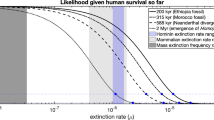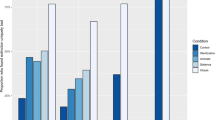Abstract
The risk of a doomsday scenario in which high-energy physics experiments trigger the destruction of the Earth has been estimated to be minuscule1. But this may give a false sense of security: the fact that the Earth has survived for so long does not necessarily mean that such disasters are unlikely, because observers are, by definition, in places that have avoided destruction. Here we derive a new upper bound of one per billion years (99.9% confidence level) for the exogenous terminal-catastrophe rate that is free of such selection bias, using calculations based on the relatively late formation time of Earth.
Similar content being viewed by others
Main
Fears that heavy-ion collisions at the Brookhaven Relativistic Heavy Ion Collider might initiate a catastrophic destruction of Earth have focused on three possible scenarios: a transition to a lower vacuum state that propagates outwards from its source at the speed of light2; formation of a black hole or gravitational singularity that accretes ordinary matter2; or creation of a stable ‘strangelet’ that accretes ordinary matter and converts it to strange matter3. A careful study1 concluded that these hypothetical scenarios are overwhelmingly more likely to be triggered by natural high-energy astrophysical events, such as cosmic-ray collisions, than by the Brookhaven collider.
Given that life on Earth has survived for nearly 4 billion years (4 Gyr), it might be assumed that natural catastrophic events are extremely rare. Unfortunately, this argument is flawed because it fails to take into account an observation-selection effect4,5, whereby observers are precluded from noting anything other than that their own species has survived up to the point when the observation is made. If it takes at least 4.6 Gyr for intelligent observers to arise, then the mere observation that Earth has survived for this duration cannot even give us grounds for rejecting with 99% confidence the hypothesis that the average cosmic neighbourhood is typically sterilized, say, every 1,000 years. The observation-selection effect guarantees that we would find ourselves in a lucky situation, no matter how frequent the sterilization events.
Figure 1 indicates how we derive an upper bound on the cosmic catastrophe frequency τ−1 that is free from such observer-selection bias. The idea is that if catastrophes were very frequent, then almost all intelligent civilizations would have arisen much earlier than ours. Using data on planet-formation rates6, the distribution of birth dates for intelligent species can be calculated under different assumptions about the rate of cosmic sterilization. Combining this with information about our own temporal location enables us to conclude that the cosmic sterilization rate for a habitable planet is, at most, of the order of 1 per 1.1 Gyr at 99.9% confidence. Taking into account the fact that no other planets in our Solar System have yet been converted to black holes or strange matter1,2,3 further tightens our constraints on black hole and strangelet disasters. (For details, see supplementary information.)
The probability distribution is shown for observed planet-formation times, assuming catastrophe timescales, τ, of 1, 2, 3, 4, 5, 6, 7, 8, 9, 10 Gyr and infinity (shaded yellow), respectively (from left to right). The probability of observing a formation time ≥9.1 Gyr for Earth (area to the right of the dotted line) drops below 0.001 for τ<1.1 Gyr.
This bound does not apply in general to disasters that become possible only after certain technologies have been developed — for example, nuclear annihilation or extinction through engineered microorganisms — so we still have plenty to worry about. However, our bound does apply to exogenous catastrophes (for example, those that are spontaneous or triggered by cosmic rays) whose frequency is uncorrelated with human activities, as long as they cause permanent sterilization. Using the results of the Brookhaven analysis1, the bound also implies that the risk from present-day particle accelerators is reassuringly small: say, less than 10−12 per year.
References
Jaffe, R. L., Busza, W., Sandweiss, J. & Wilczek, F. Rev. Mod. Phys. 72, 1125–1140 (2000).
Hut, P. & Rees, M. J. Nature 302, 508–509 (1983).
Dar, A. & De Rujula, A. Phys. Lett. B 470, 142–148 (1999).
Carter, B. in IAU Symposium 63 (ed. Longair, M. S.) 291–298 (Reidel, Dordrecht, 1974).
Bostrom, N. Anthropic Bias: Observation Selection Effects in Science and Philosophy (Routledge, New York, 2002).
Lineweaver, C. H., Fenner, Y. & Gibson, B. K. Science 203, 59–62 (2004).
Author information
Authors and Affiliations
Corresponding author
Ethics declarations
Competing interests
The authors declare no competing financial interests.
Supplementary information
Rights and permissions
About this article
Cite this article
Tegmark, M., Bostrom, N. Is a doomsday catastrophe likely?. Nature 438, 754 (2005). https://doi.org/10.1038/438754a
Published:
Issue Date:
DOI: https://doi.org/10.1038/438754a
This article is cited by
-
The Causal Closure of Physics in Real World Contexts
Foundations of Physics (2020)
-
Integrative variants, haplotypes and diplotypes of the CAPN3 and FRMD5 genes and several environmental exposures associate with serum lipid variables
Scientific Reports (2017)
-
The past, present and future supernova threat to Earth’s biosphere
Astrophysics and Space Science (2011)
-
We're all going to die
Nature (2007)
-
Astrophysics in 2006
Space Science Reviews (2007)
Comments
By submitting a comment you agree to abide by our Terms and Community Guidelines. If you find something abusive or that does not comply with our terms or guidelines please flag it as inappropriate.




